This season, Atlético Madrid have not provided the performance to match the supporters’ expectations. In La Liga, they sit 13 points behind the league leaders Barcelona; their title hopes are almost gone. In the UEFA Champions League, Diego Simeone’s side had a very disappointing campaign because they finished at the bottom of Group B, below FC Porto, Club Brugge, and Bayer 04 Leverkusen — they could not even make it into the UEFA Europa League for the rest of the season. Therefore, there was some talk of reconstructing the player group with several youngsters, and one of the names we have heard about is Samuel Lino, a 22-year-old Brazilian who was on loan at Valencia from Atlético Madrid.
At Valencia, Gennaro Gattuso trusted Lino as he started every La Liga game this season, and he also played 97% of the total possible minutes on the pitch. When he was a kid, he played in the futsal team of a local Brazilian side, but he did not shine in the Brazilian league. Instead, Lino went to Portugal as he signed for Gil Vicente in 2019, where his performance attracted Atlético Madrid to pursue a permanent transfer for the player. This tactical analysis is a scout report of Lino that details his profile and explains how he can thrive under Gattuso’s tactics at Valencia.
Data analysis
In the first part of the analysis, we are using the stats to evaluate Lino’s level compared to other La Liga wingers.
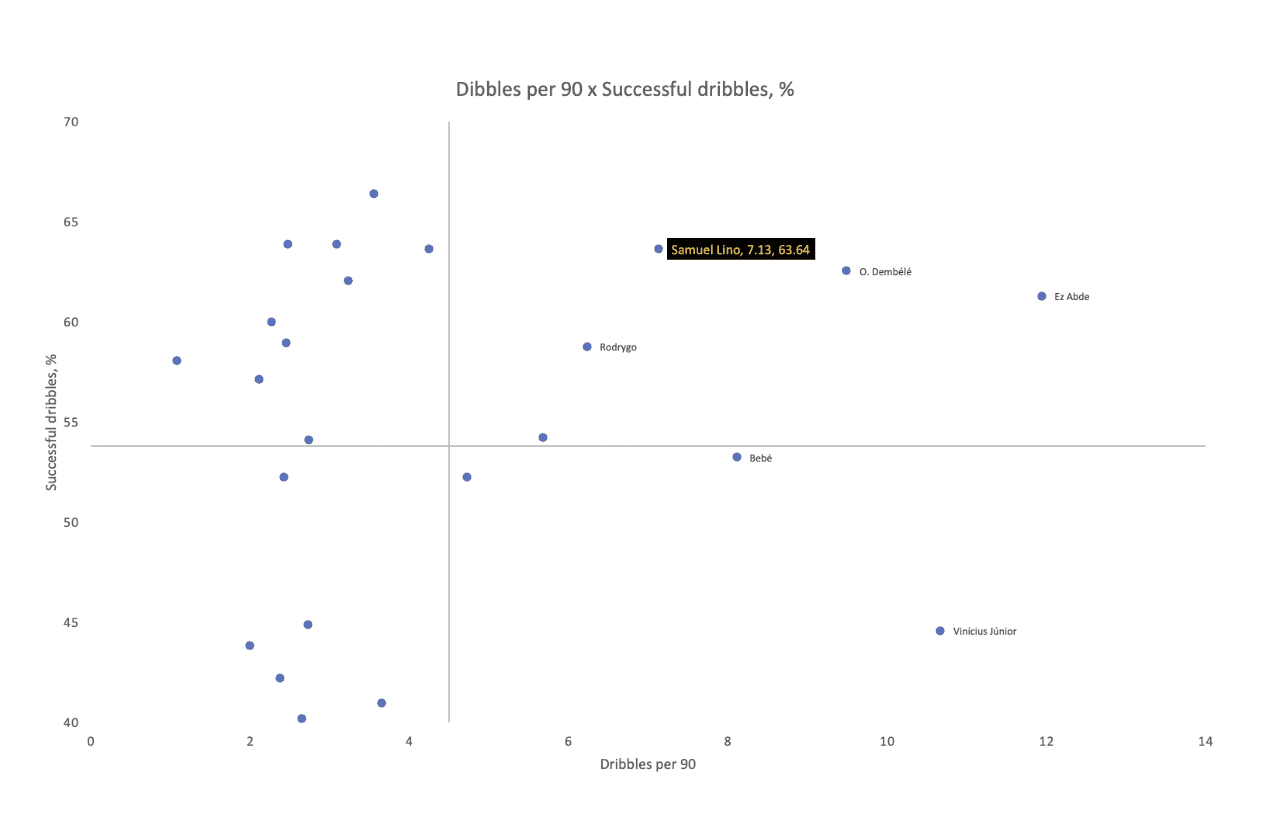
The first image includes the dribbling performance of La Liga wingers, we also included a few other names who were outstanding in Spain. Lino had a really good successful dribble % at 63.64%, which was even higher than Vinícius Júnior, Rodrygo, and Ousmane Dembélé. Although the numbers were not an absolute standard to judge the player as all of the above names had different skill sets, Lino showed he has potential in this regard. He is also very aggressive at trying to take on the opposition with 7.13 dribbles/90, which was higher than Rodrygo but not as good as Bebé, Vinícius and Dembélé, but that number already ranked fifth in the league.
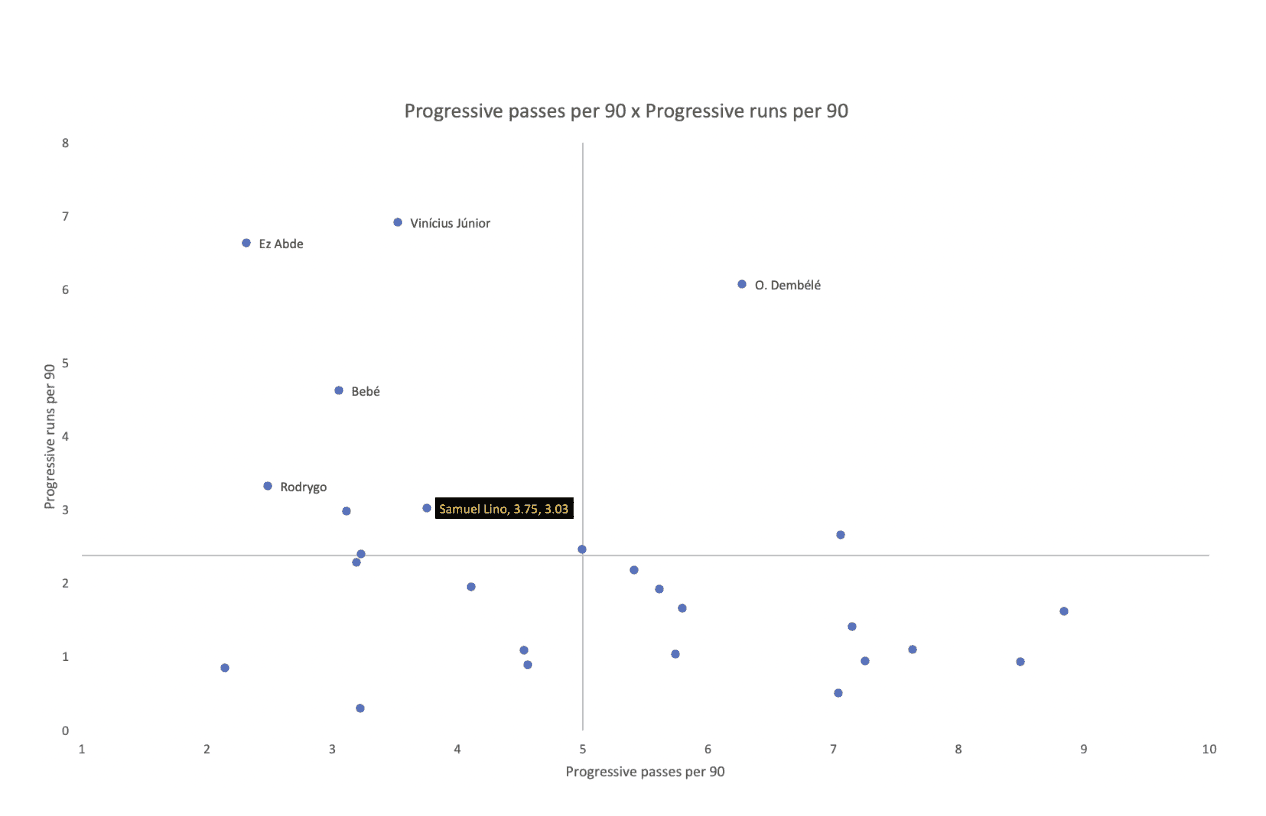
Next, we looked at Lino’s offensive contribution to his team’s ball progression in the attack. Lino, unsurprisingly, was not doing too well — he has below average progressive passes/90 compared to other wingers, but the same trend was also shown in Vinícius, Bebé, and Rodrygo’s numbers, and that was because of the player’s position and team playing style.
When we compared his ability to carry the ball, Lino has 3.03 progressive runs/90, not as high as the Real Madrid and Barcelona wingers but still higher than the league average. It shows he was not only dribbling for the sake of dribbling but also having the capacity to bring the ball forward into advanced areas.
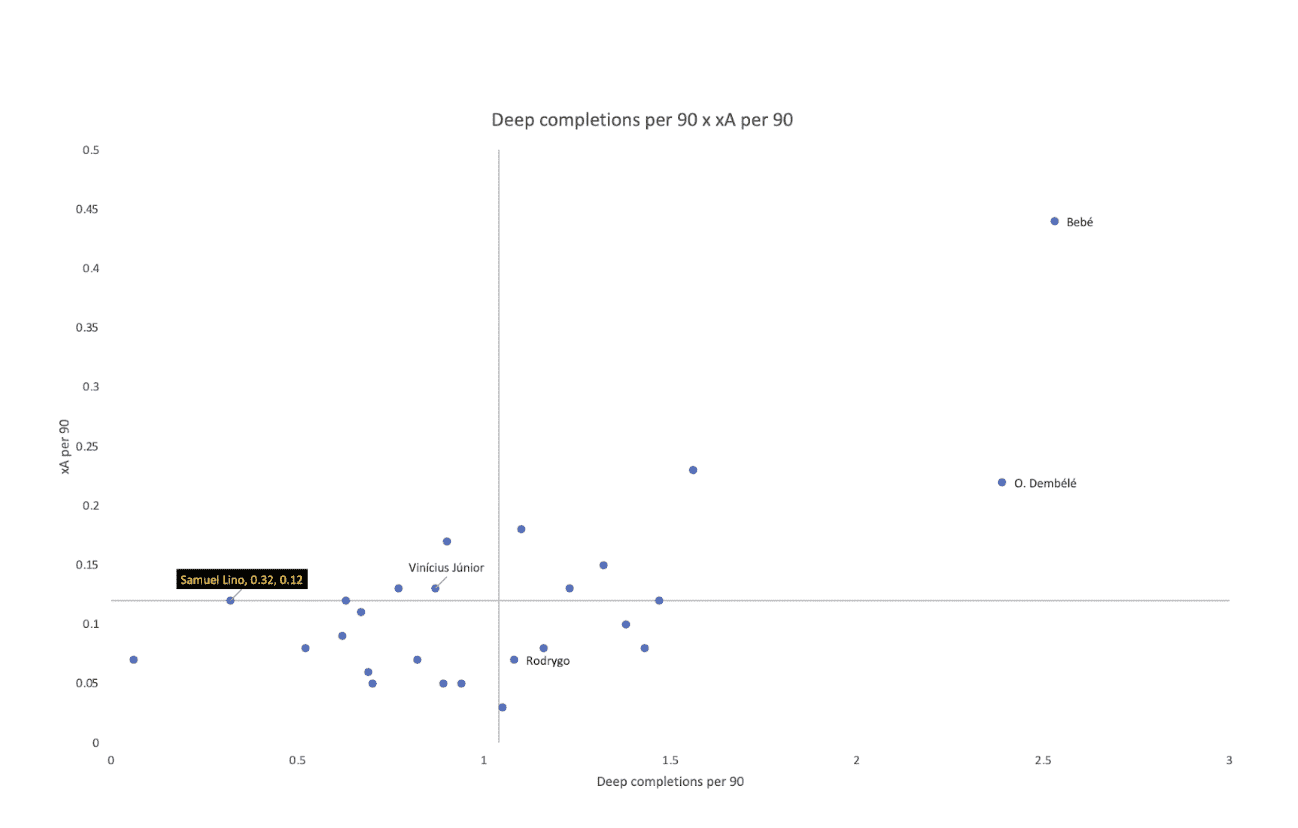
We also evaluated Lino’s output on the ball in chance creation with deep completions/90 and xA/90. Lino’s deep completion/90 was 0.32, one of the lowest in La Liga and if you also looked at Bebé and Dembélé’s numbers, this is a part he could work on — how to deliver the ball into those areas. But still, Lino had a desired xA/90 at 0.12, even higher than Real Madrid’s Rodrygo, we believe this was not his limit and if his deep completions increased in numbers, he could have a better xA as well.
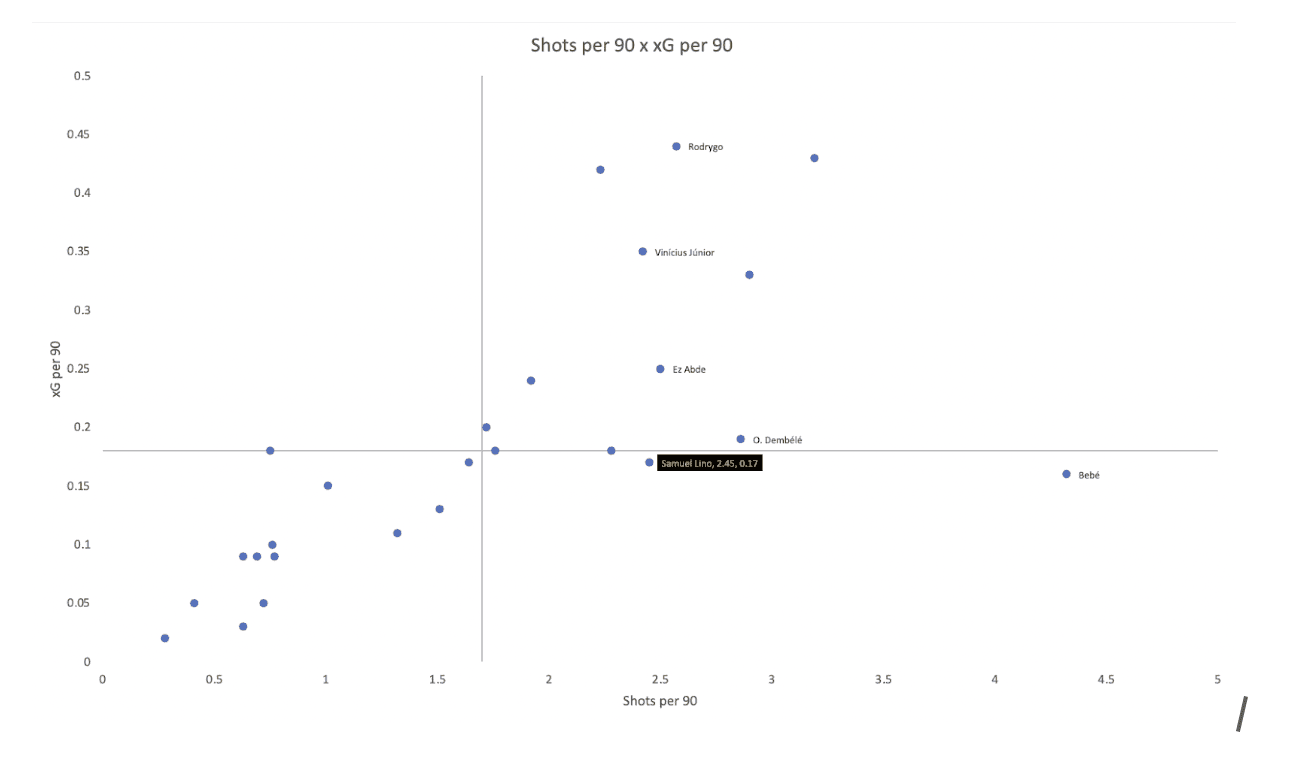
We also measured Lino’s threat to goal with xG/90 and shots/90, this was a part he could yet improve with practice. Lino takes 2.45 shots/90, which was higher than most wingers in La Liga and even higher than Vinícius. However, when we compared the xG/90, Lino only had 0.17, slightly below average. Considering he has a similar amount of shots to Vinícius, the difference in xG value (0.17 vs 0.35, almost a double), tells us that Lino did not take shots in positions close enough to the goal. The quality of chance was not as good as his compatriot’s.
Attacking style of play
Then, after the stats as an introduction, we are using more vizzes with in-game situations to analyze Lino’s quality as a player.
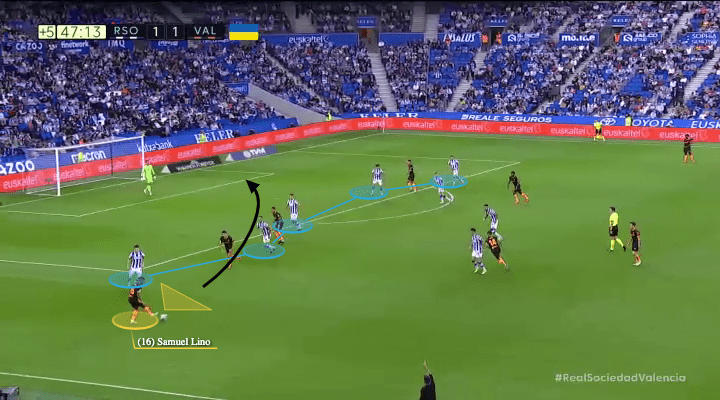
Lino tends to use his right foot to control the ball when the pass is usually coming from José Gayà or from the centre. It helps him to adjust his body angle facing the centre, where he was so used to curling inswingers to teammates awaiting centrally. As shown in the example vs Real Sociedad, Lino opens up his body and prepares to put the ball in from this angle, it happens a lot in his game.
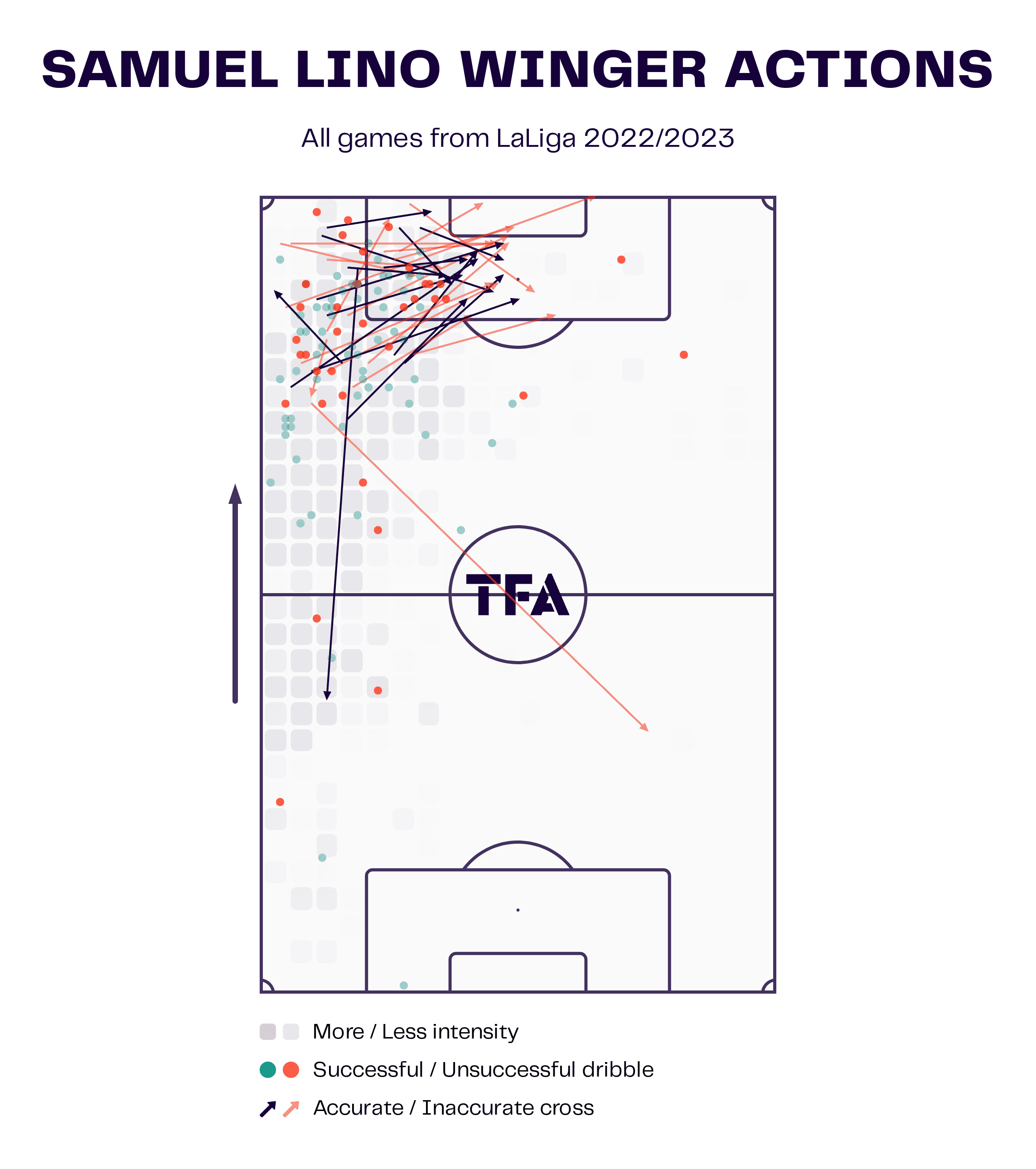
However, even if it was the usual way for the player to deliver the ball into the final third, he has to work on the end product and the consistency of his delivery. This viz shows the actions of Lino. There were a lot of dribbles on the sides, and many of them were successful which matched the stats. But in terms of crosses, Lino’s delivering direction could be arguable, because he rarely put the ball to the second post. Instead, most of them were targeting the near post, and that might be too predictable for the opponents.
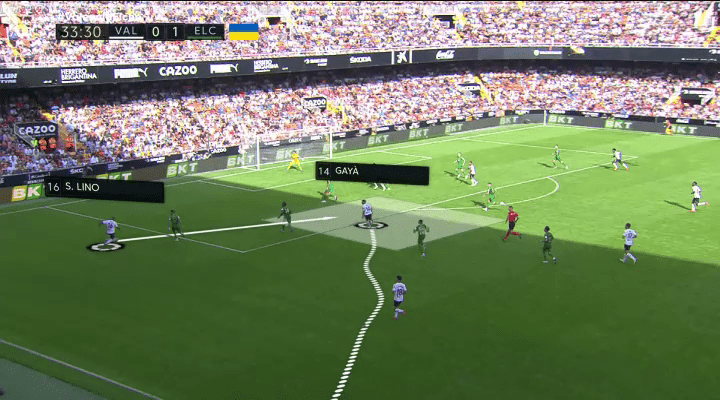
But there is also another skill in Lino’s toolbox — sometimes, he likes to use the left foot to hit a hard and low pass/cross in the first contact. But that would not be going to the far post either. For example, he collaborated with Gayà in this example and the cross came from his left foot.
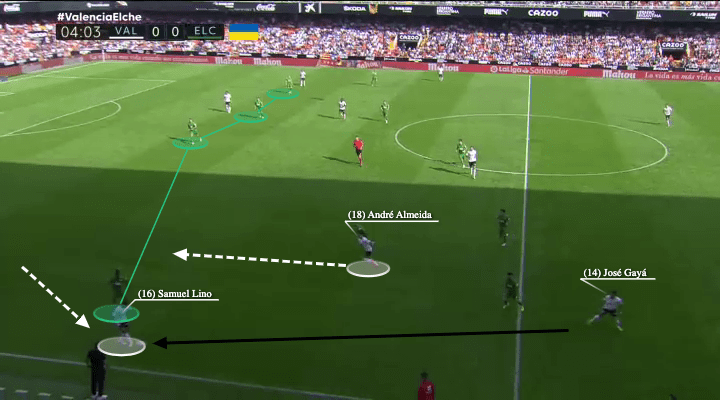
When it comes to the controlling foot, Lino was also too heavily leaning on his right foot and on occasions that did not help him to open up his body. In this example against Elche, because he wanted to control the ball with his right foot, he maybe unconsciously put his back to the opposition and that did not help his next action. So even though André Almeida was making a run into the channel, Lino could not find the angle to play a forward pass because of that.
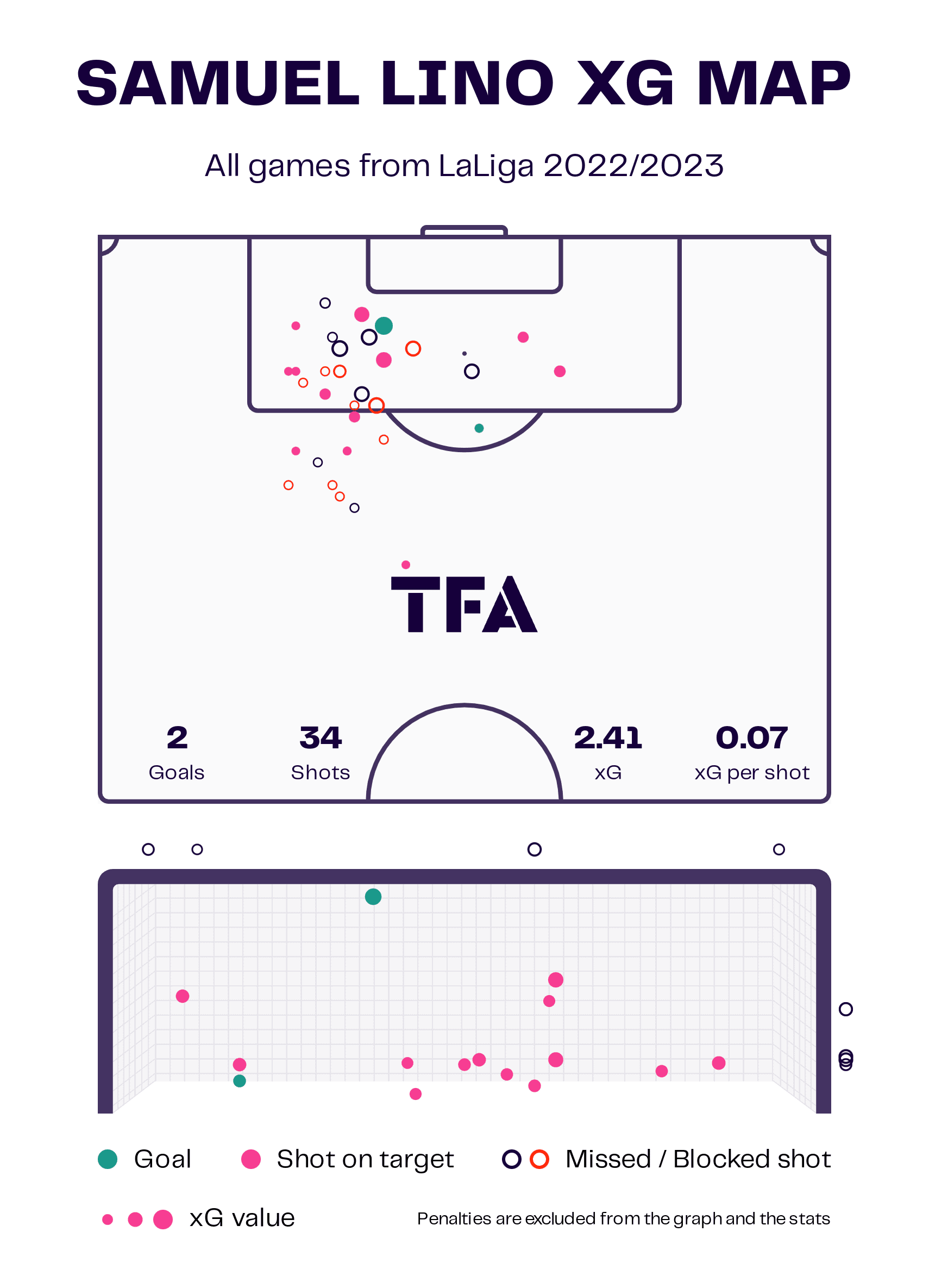
As we have suggested, Lino’s end product has to be better, not only in the crosses but also in the goal-scoring actions. This season he has taken 34 shots, and accumulated 2.41 xG but only resulted in two goals. To explain these sets of numbers, we could simply Lino was underperforming when it comes to shooting and finishing. Another reason was he could not get into a good position to score, which was matching the data analysis where we made the comparison with Vinícius. You could see his shooting position was mostly on the left side of the box, and he rarely took shots centrally, so if he worked on his arriving position, timing, and techniques, he could have gotten more goals. The bottom of the viz shows the shot direction of Lino, and a clear trend was he could not bend the ball to the right side of the goal. Many attempts went to the bottom and centrally, which was not a difficult task for the goalkeeper.
Under Gattuso’s game model
Lino was a key player in Gattuso’s Valencia, as his playing time suggested his importance to the team. This section explains how the former Napoli coach tried to get out of the best from the Brazilian with his system.
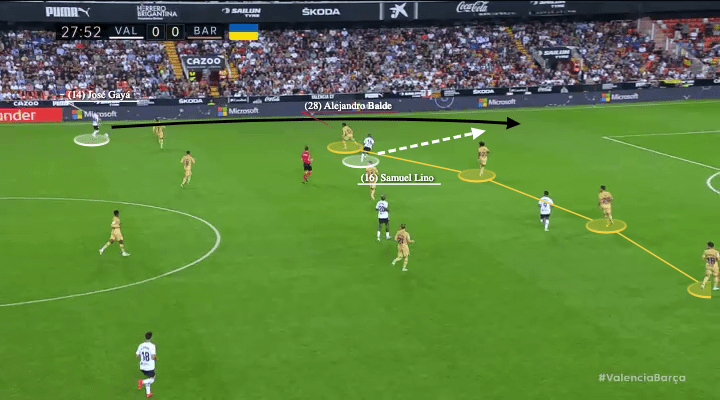
Firstly, Lino is a player blessed with good physical quality, including the pace to outrun defenders and sharp acceleration in a short time. Valencia would use his speed a lot in the last part of the attack, usually when it comes to breaking the last line. Usually, Valencia attracted the opposition full-back to press and when that happens, Lino would take advantage of spaces created behind the wide defender and run into the space, looking for a long ball from a teammate.
Here, Gayà with the ball and Barcelona’s Alejandro Balde was moving outward, then Lino quickly attacked the channel and was released by Gayà’s through ball.
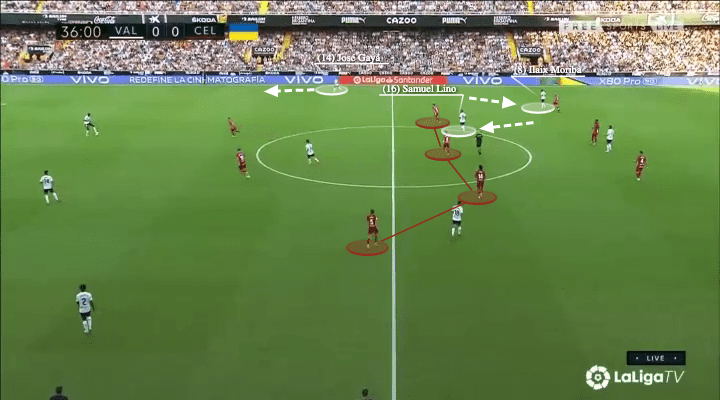
Valencia’s construction of the first goal against Celta de Vigo would be a great example to illustrate that tactic and Lino’s individual quality in offensive actions. Initially, Lino drifts inward and stays behind the second in the half-space, which was his common behaviour because he was not a high and wide player staying on the touchline. Instead, he enjoys roaming on the pitch more, to be in a position where he feels most comfortable to be with.
Then, tactically, it was also a move that can be explained by rotations, as the movement of Lino could connect with others such as the 8 and the left-back. Here we can see Ilaix Moriba went outside because Lino was inside, which could create confusion on the right back.
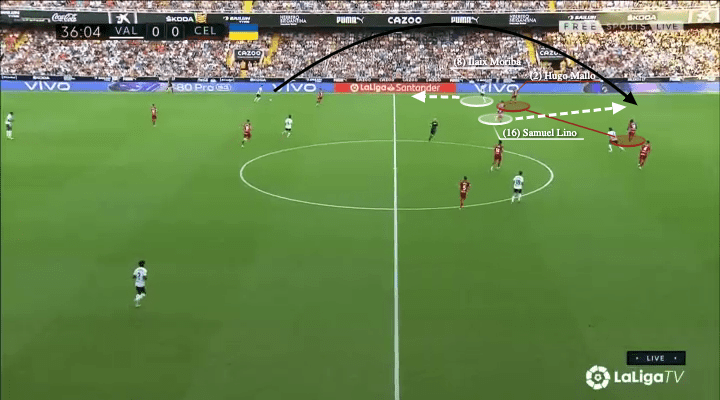
In the next image, it was clear that Hugo Mallo was affected by the rotations, as the Celta right-back committed to Moriba, but Moriba isn’t the player receiving. Instead, Lino read the decision of Mallo and he suddenly made the run from deep. But Celta were not dead yet because their midfielder, Fran Beltrán, would be tracking.
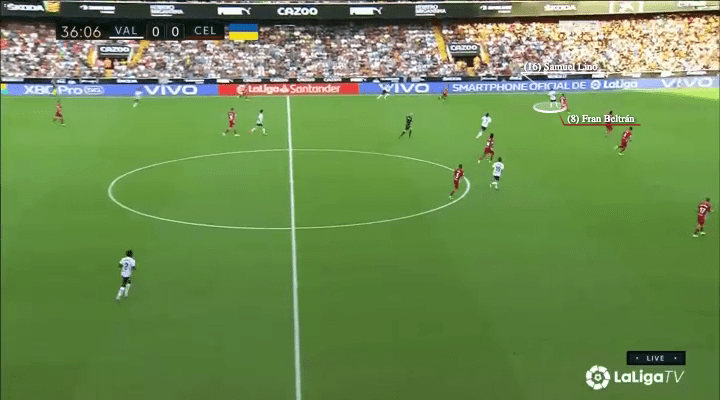
Nevertheless, Lino showed his quality off the ball movement in the setup of the goal. In the first moment, he paused after the sudden sprint, which looked like he was going to control the dropping ball from the air. And that also affected Beltrán’s defending, as he perceived that message and stopped with Lino.
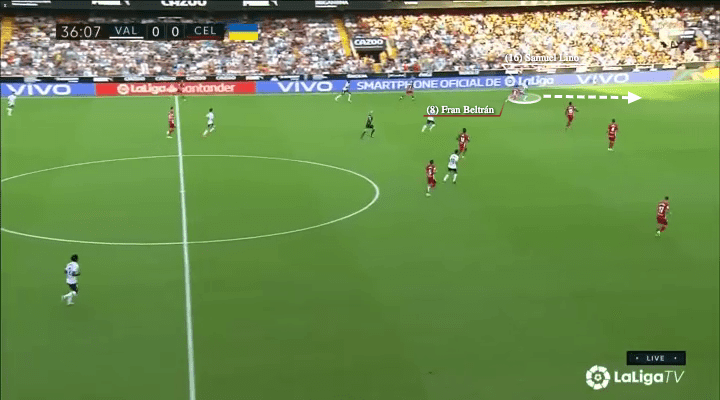
But all of these were just decoys and mind games from Lino. The initial break of the Brazilian was merely a technique to make his marker stop, when that happened, he sprinted again into his space behind, letting the ball bounce on the floor and did not take the touch first. Beltrán was totally caught as he could not match Lino’s pace after he stopped on that instance, then Lino got rid of the marker and his further action created the first goal for Valencia.
Conclusion
Could Lino become the new hope of Atlético Madrid? We don’t know. As we suggest in the analysis, he is a talented player with gifted qualities in his body, but there were also aspects he had to improve. This season was important to his football career because, under Gattuso, he was given so many chances to play and experience a top division in Europe. It will be intriguing to see if Simeone wants him back at Atlético Madrid in 2023/24.

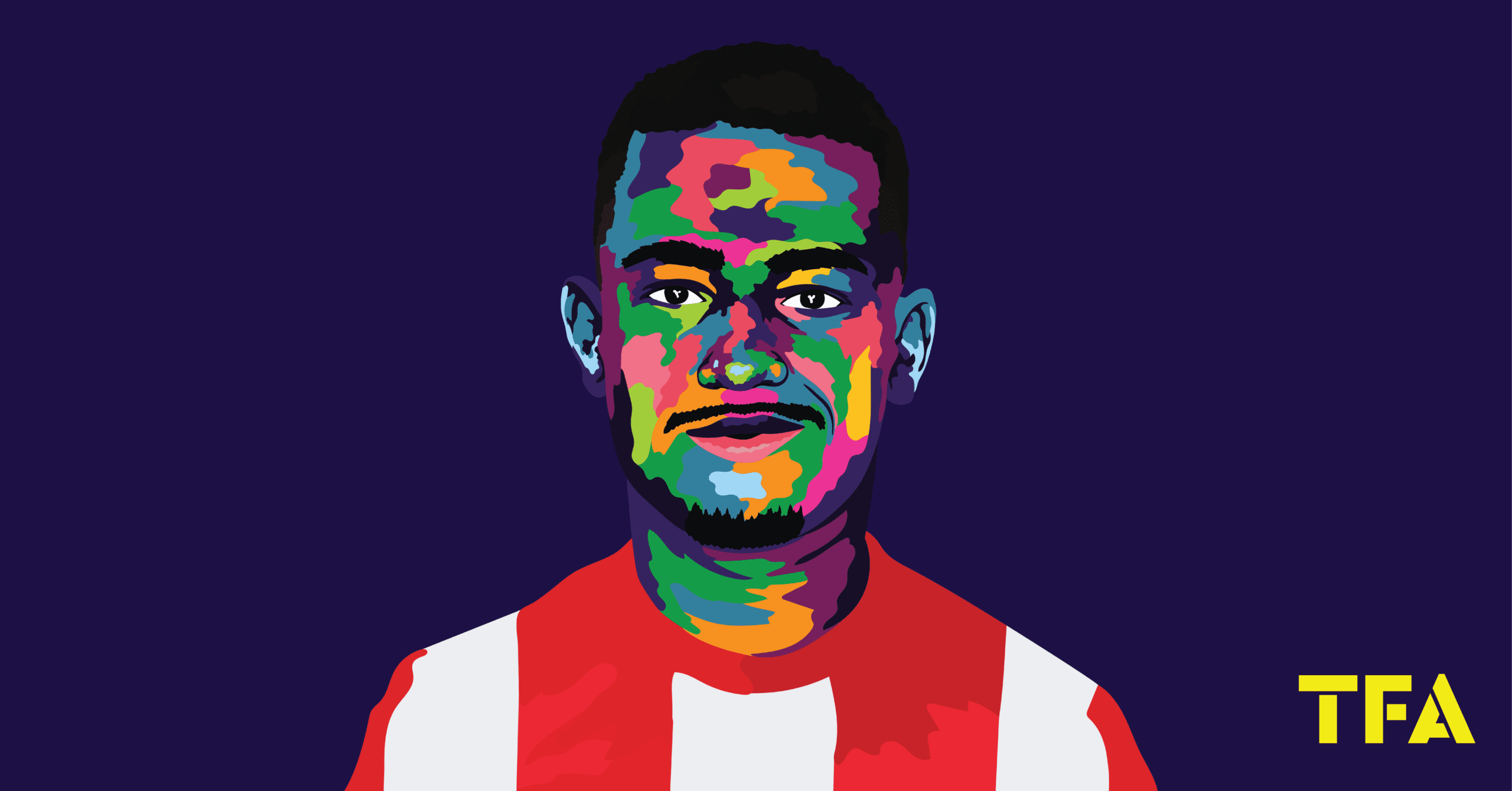


Comments